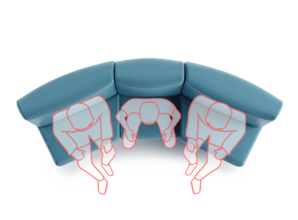Hide & seek practice idea
Trace the perimeter and thresholds of a ward (communal space) with tape on the floor of a dance studio or similar. Bring in objects that could be found on a ward - Pineapple chair, table, medical screens, curtains etc.
Create structures using materials from the ward - white rock, sanitisable surfaces, plastic etc.
Framing it as a game bring in the playful (deviant) aspect and provides a frame of reference that is universally understandable.
Links to pathoplasty as creating possibilities for 'real encounters'.
- What role do the objects and material conditions of locked psychiatric wards play in inpatients’ clinical encounters and lived experience of hospitalisation?
- How can arts-based research methods be used to explore and provide insight into the nature of inpatients’ clinical and material encounters?
- To what extent do queer methodologies offer a critical framework to conceptualise mental health care in locked psychiatric facilities?
- To what extent can arts-based research methods and queer methodologies reframe the role of participants with lived experience of hospitalisation as agents of research rather than objects of narration?



